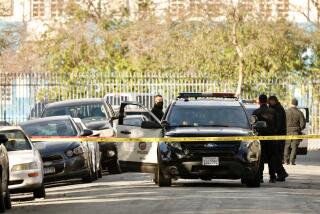Police Emergency Response Time Sharply Reduced
- Share via
The Los Angeles Police Department said Monday that it has shaved nearly a minute off the time it takes to respond to an emergency.
It typically took 8.1 minutes to respond to an emergency during the first six months of this year, compared to 8.9 minutes during the first six months of last year, the Police Department said.
Police defined an emergency as a life-threatening or potentially life-threatening situation.
Department officials have vowed to bring the typical emergency response time down to 7 minutes by next summer.
The improvement this year came despite more emergency calls. The department reported receiving 39,900 emergency calls during the first six months of this year, up from 35,900 in the same period last year.
The biggest gains came in the Central Bureau, where typical emergency response times were cut from 8.8 minutes to 7.5 minutes, and in the South Bureau, where times went from nine minutes to 7.9 minutes.
Central Bureau includes the department’s Northeast, Newton, Central, Rampart and Hollenbeck divisions. South Bureau includes the Harbor, 77th Street, Southwest and Southeast divisions.
Better Training Cited
In calculating the times, the department dropped, as unrepresentative, the 10% of the calls that took the longest to answer, and the 10% of the calls that were answered the fastest. It averaged response times in the remaining 80% of the calls.
Asked what accounted for the improvement, the department’s response time coordinator, Cmdr. Jim Jones, cited several factors, including “better training . . . (that) . . . comes from setting response time as something that is really high priority,” and the hiring of additional officers.
The department now has 7,430 officers. A year ago, it had 7,050.
Jones, assistant to the director of the department’s Office of Operations, said high-ranking officers in some areas were urging detectives, as well as patrol officers, to respond to emergencies, and were assigning one radio car in an area to steer clear of routine calls so that it could be ready for an emergency.
Jones said the department has also increased use of one-officer cars to take crime reports, thus freeing more two-officer cars to handle emergencies.
That was among the recommendations of a consultant hired by the department and the Police Commission to determine efficiency of officer deployment.
The consultant, Public Administration Service, a private, nonprofit Virgina firm, was hired following charges by some community leaders that the department favored affluent areas over poorer ones.
The consultant found one striking inequity--that officers in affluent areas had more time to patrol. But they concluded that every neighborhood was being shortchanged. They said the Police Department does not commit enough of its 3,000 patrol officers to actually patrolling the city, and therefore does not respond quickly enough to calls for help.
They said the department diverts too many patrol officers to a variety of special assignments, such as truancy and narcotics.
The consultant suggested that the department scrap the mathematical formula it had used for years to assess how many patrol officers to assign to an area and replace it with a more complex, computerized formula. The department agreed--at the same time embracing the goal of a seven-minute response time.
LAPD’S IMPROVED RESPONSE TIMES
Typical emergency response times have decreased over the last six months compared to the same period in 1987, Los Angeles police say. During the same period, the number of emergency calls has increased.
EMERGENCY RESPONSE TIME
(In Minutes)
1987 1988 Central Bureau 8.8 7.5 South Bureau 9.0 7.9 West Bureau 9.0 8.6 Valley Bureau 8.7 8.4 Citywide 8.9 8.1 TOTAL CALLS 35,964 39,951
More to Read
Sign up for Essential California
The most important California stories and recommendations in your inbox every morning.
You may occasionally receive promotional content from the Los Angeles Times.










